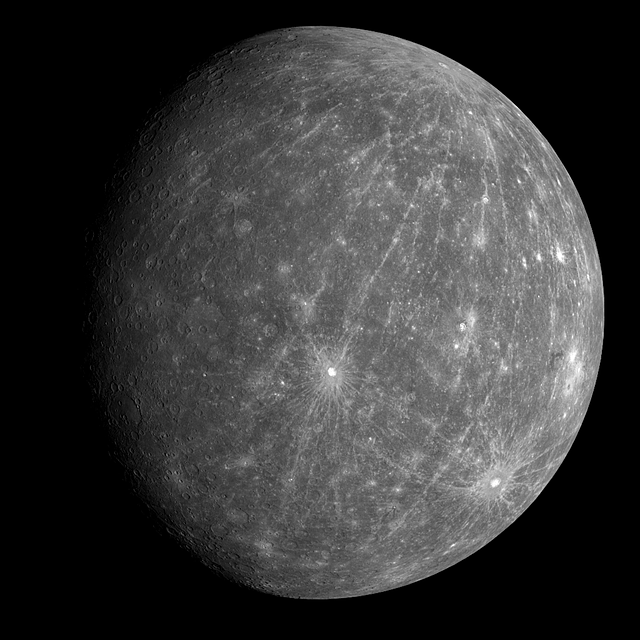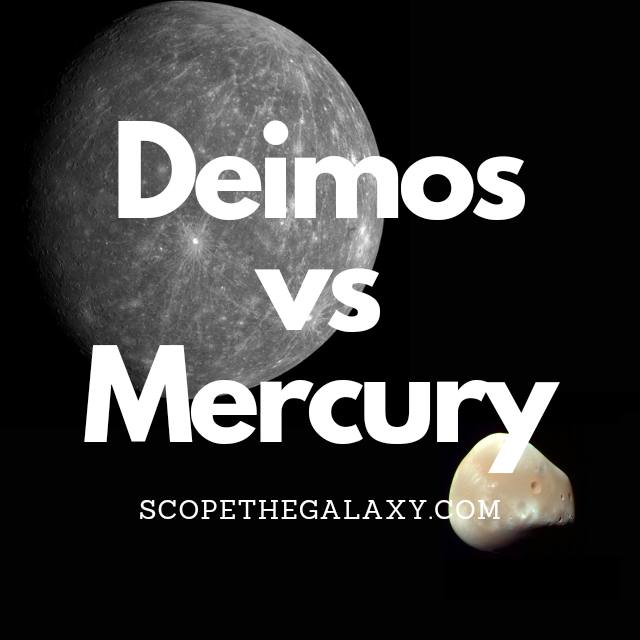*This post may contain affiliate links. This means we may make a commission if you purchase an item using one of our links*
The main differences between Deimos and Mercury are that Deimos is a natural staellite that orbits Mars while Mercury is a planet that only orbits the Sun, Deimos is far smaller with a diameter of 12.4km compared to Mercury’s 4,879km and Deimos is tidally locked to Mars while Mercury is in a 3:2 orbital resonance with the Sun.
For a more detailed look at each entity along with their similarities, continue reading as it will be covered more thorughly in the sections below.
What Is The Moon Deimos?
Table of Contents

Deimos is the smaller and outermost of the two moons of Mars, named after the Greek God of dread and terror (the brother of Phobos). This satellite was also discovered by American astronomer Asaph Hall just five days before Phobos (12th August 1877).
Scientists like Johannes Kepler had put forward theories for the existence of these moons many years before they were discovered. Their calculations were based on the fact that the planets on either side (Earth and Jupiter) possessed one and four moons, respectively.
Still, none were discovered until the 19th century. One of the main reasons for this is that the tiny size of Phobos and Deimos, combined with an exceptionally close orbit to their planet, means that the glare of Mars often obscures our view of them.
Phobos measures just 15 x 12 x 11 km and completes an orbit of Mars once every 30 hours.
This tiny moon is also a heavily cratered landscape shaped by the impact of asteroid collisions over time. However, the material thrown up from these impacts doesn’t appear to have landed back on the moon’s surface as it usually would. This could be because the lack of gravity on Phobos allowed the ejected material into space.
The surface gravity on Deimos is just 0.003 m/s^2 (compared to 9.807 m/s^2 on Earth), which means the average gravitational pull of Deimos is only 0.003 m/s. With only 1/2500th of Earth’s gravity, you would need a tether to walk on this rocky moon, or every step would put you at risk of achieving escape velocity and launching yourself into space.
The composition of Deimos is similar to Phobos, suggesting that it might also be a captured asteroid. Its surface is very dark gray and has an albedo of around 0.07, meaning it reflects just 7% light (about half of the light Earth’s moon can reflect).
What Is The Planet Mercury?

Mercury is the planet closest to our Sun and would fall under the terrestrial planet moniker. Out of the 8 main line planets Mercury is also the smallest, coming in at 4,879km.
This planet is known for having its fair share of craters, which is mostly down to its thinner non protective atmosphere that is unable to stop interstellar debris from striking its surface.
Despite its close proximity to the Sun, Mercury is not the hottest planet in our solar system but, it does come in second, just behind Venus. It’s surface temperature is around 430 degrees on the upper end with the average temperature around 167 degrees Celsius whereas its core is far hotter at around 1,600 – 3,000 degrees Celsius.
Due to it close proximity to our local star, Mercury is unable to sustain a moon around its orbit and even has a very unique rotation around the Sun where it has 3:2 orbital resonance with the Sun.
As for how long it takes for the planet to rotate around our yellow dwarf star, its the shortest time period of 88 days for obvious reasons, whilst a single day on the planet takes 58.65 Earth days to complete. Its axial tilt is only 2 degrees to the right, making it amongst the straightest planets in the solar system too.
Similarities Between Deimos And Mercury
Deimos and Mercury do have their fair share of similarities, which in this case would include the following:
- Both have a hotter central core.
- Both are terrestrial planets.
- Both have a very thin atmosphere and a rocky surface.
- Both have no other natural satellites orbiting them.
- Neither have tectonic plates.
- Both have an axial tilt of 2 degrees.
Differences Between Deimos And Mercury
As for the differences between the two, they include the below.
- Deimos orbits Mars whilst Mercury only orbits the Sun.
- Mercury is a spherical shape while Deimos is not.
- Mercury is a terrestrial planet whilst Deimos is a terrestrial based natural satellite.
- Mercury has a diameter of 4,879km whilst Deimos has a diameter of 12.4km.
- Deimos has no atmosphere whilst Mercury has very thin atmosphere composed of oxygen, sodium and hydrogen.
- A day on Deimos takes 30 hours whilst a Mercury day takes 58.65 days.
- It takes Deimos 30 hours to orbit Mars and around the Sun in 687 days whilst Mercury orbits the Sun in 88 days.
- Deimos’ temperature ranged between -4 to -112 degrees Celsius whilst Mercury has an average temperature of 167 degrees Celsius.
- Mercury’s density is 5.43 g/cm³ whilst Deimos’ density is 1.47 g/cm³.
- Mercury’s mass is 3.285 × 10^23 kg whilst Deimos’ mass is 1.4762 × 10^15 kg.
- Deimos’ gravitational strength is 0.003 m/s² whilst Mercury’s is 3.7 m/s².
- Deimos is tidally locked to Mars whilst Mercury is is not tidally locked to any entity but is in a 3:2 orbital resonance with the Sun.
- Mercury has a magnetosphere whilst Deimos does not.
Summary
In conclusion Mercury and Deimos are clearly very different from one another, from their phyiscal shape to the fact one is a planet and the other a natural satellite.
Despite the fact Mercury and Deimos inhabit the same solar system and are both rock based celestial bodies, they are very easily disntiguishable just based on their shape alone.

